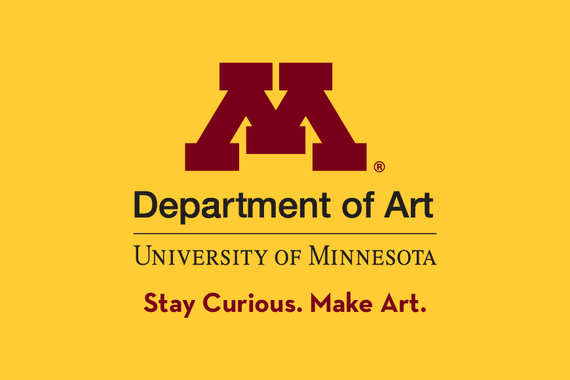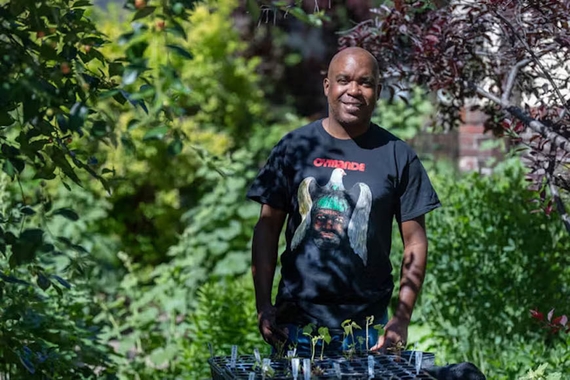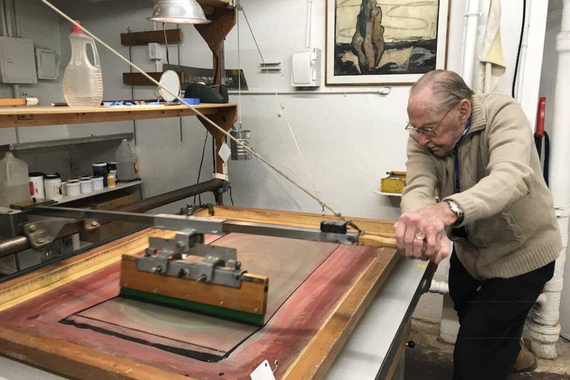Chronicling Legacy Through Clay's Transformative Power
Interview highlights have been lightly edited for length and clarity.
How did you become interested in studying quilts?
I first encountered quilts in some of my graduate research. I was just looking at what I wanted to make, what I found interesting. And I was always thinking about where I came from and who I am. Being African American, that’s something you think about a lot because you usually are the only one, and that was my experience in graduate school. I had a wonderful graduate professor, Denise Ward-Brown, who stumbled into my studio one day while I was making these vessels and cutting them in half and putting different parts together in different ways. She came in and asked me a slew of questions that no one had ever asked me before—what I was doing, why I was doing it—which was new to me outside of the kind of format in which you can work sequentially. (When you’re working with clay, there’s a process you can rely on and there are things you can explore and discover, but obviously you’re part of that process.) She was really integral in getting me to see how I could find myself in that process. And it led me to take my research in a different direction, not just thinking about the clay I’m using, the type of clay body, or the type of glaze, but what am I bringing to that? How do I understand what choices I’m making? My epistemology, if you will. How do you know what you know?
Quilts offered me a way to think about disparate parts coming together to make a whole. And one thing I learned was that on plantations, enslaved women weren't just making what we know today as African American quilts, which are polyrhythmic, bright in color, and bold in design, but they were actually also producing a lot of quilts under the direction of their owners, their oppressors. They brought with them the skills of sewing, weaving, working with fabric, so those things weren't new, they just had to put them in a different direction; they had to learn how to articulate the aesthetics of their oppressors’ culture.
Once I started looking deeper into the quilts, I started thinking more deeply about the material they're made of: the cotton, the fullness of this material. They're made of the very commodity these women have to labor over and pick all day. Then it leaves the plantation and when it comes back to them, it's transformed. And that's the same type of process that happens with ceramics. You start with the material that's in the earth and it goes through this transformation and looks completely different. You know, all these different veins in the earth are mined and combined, and it's the same thing with the cotton. It starts as this vegetation, this plant that grows, but it comes back by way of Sears and Roebuck and fashionable textiles with patterns and design.
And the kind of split that there is, the quality fabric goes first for the mistress of the plantation and with power in that oppressor role in relationship to the women who have to follow these orders in terms of making quilts that reflect the culture of the plantation, but they get the scraps in any way that they can, because they still have to sew clothes for their children and still need to make coverings for themselves. So, they're getting what's left over, and that's what I'm really interested in.
What do you find most fascinating about cotton and clay?
As I looked at the quilts and these traditions, these histories, these women, and I leave the plantation, I’m automatically set upon the Atlantic Ocean, the Pacific Ocean, any way you get from continent to continent. Cotton has touched every continent and so has clay. So, they’re kind of separated at birth, if you will, materials with which I’m always reacquainting and trying to get them to have a reunion. I’m interested in how they’ve affected how we live our lives, how they’ve affected commerce, what it means for labor, how they enter our homes, how they enter our everyday lives. Both do, but in such different and very powerful ways.
No other material, and I've researched this, has impacted the world in commerce as cotton has. Cotton has the ability to wick away moisture, to absorb color, to really express an individual when you put clothes on. Clay has the same thing. It has a range in terms of its technology, from storing food to helping bring a space shuttle back to Earth—because they're using a type of porcelain and silica sand that can withstand the heat and the temperature in the atmosphere as the astronauts return. They’re two incredible materials to work between.
Again, like clay, the transformation in a cotton plant is pretty incredible. It starts out as this delicate flower that eventually grows into this kind of hard round bulb and it's like that for a really long time. Something's happening inside, and that's just like the kiln. I can't get in the kiln with the work and see what's happening, but I did eventually drop one of those bulbs and it cracked open and I looked inside and I could see the fibers beginning to form in there. And I knew I had stopped the process because I opened it, and it could be the same thing with a kiln.
What makes your work unique?
My peers are my friends and we motivate each other, we inspire each other. And I think the people I choose to have around me, we are the same in that we want art to have validation and to be important. So, I don’t know that I focus on how different I can look, it’s about having the community around you that supports what you do, that gives you the opportunity to talk about these ideas that seem to be so counterculture most of the time. I think that’s what I’m more concerned about rather than anything looking different. I think it’s a moot point. It’ll look different unless I’m trying to not make it look different. I think the diversity in ceramics can be natural. Now, the opposite can be totally true. People can work within a tradition and within a format, and those are very similar to each other. And I draw from both and I don’t necessarily have an allegiance to any of them. I know in clay there are always rules and I tend to try to push those rules, and I think that maybe what makes it different is my time as a technician out of graduate school.
Can you describe the relationship between your creative practice and your teaching?
My role is really to prepare my students to see something new. Part of the experience of four years in higher education is to be transformed. And what better class and material to really support that than clay? I really do work in such a way to set goals and give them things to focus on in the process so they can be free from feeling that they are set upon like in a predetermined path, “I have to make it look like this,” which can be very difficult, because you do have this rich, beautiful tradition in ceramics, of pottery and the vessel. So, it’s really hard to balance that, to get them to not fall into the status quo.
When I talk to my colleagues or my peers, I don’t come in and go, “I really like this one.” I save that for last. What I first come in and tell them is what I see happening. I just tell them the facts, what I see happening visually, what it makes me think of, where I think things are not working together because they make my eyes not focus. You know, I really try to give them a cold read. Then I’ll go around and tell them what I like. If I’m coming in to talk to someone else about their work, it’s not about me, so my preference should wait until the very end.
I want my students to understand that creativity is not only in the object you get in the end, but it's about how you think and how your thinking starts to differentiate you, how your thinking starts to help you solve something that's a problem. And I'm glad that the clay is my co-conspirator because once it's at a certain stage, there are things you can no longer do with it, but there's this beautiful thing called epoxy; you can glue it on later. You can challenge gravity, you can connect clay pieces at different points. You just have to strategize. I think clay has a wonderful way of exposing transferable skills within the liberal arts setting, which is why I think everyone should take a clay class.
What do you wish more people knew about history during the time of enslavement that you explore in your art?
Everyone pays attention when a plane crashes. I think we know that part of the history, we know it in this general way, and I think it’s exhausting in the ways that we know it. I think there aren’t enough ways in terms of describing the complexity of it and the actual length of it. And I wish more people knew some of the powerful stories that actually affected me and others who are within that ancestry—that when you have despair, you still do have hope. And I know that sounds cliché, but if they stayed in despair and believed the lies that were told to them, I wouldn’t necessarily be sitting here with the evidence of this life I’ve been able to create for myself.
I think about these sort of hidden and invisible instances that I'm looking for in history, that it's not just flattened out: there was enslavement, and now there isn't. There is a lot more to find within it that could probably help us solve a lot of problems that we even have today.


